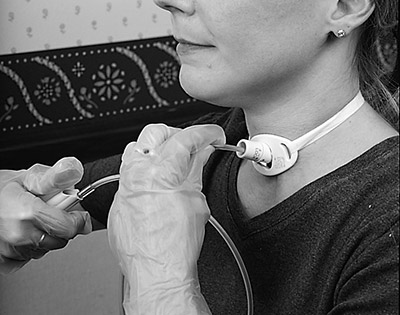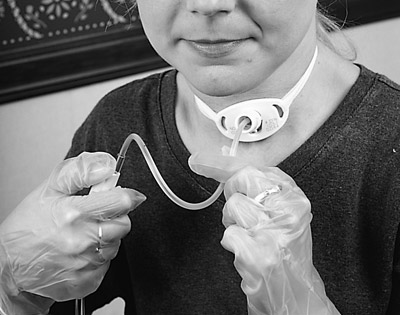Note: Always follow the directions from your doctor or hospital if they differ from the directions in this guide. Carefully review the applicable clinical guidelines with your doctor or home healthcare provider to determine the appropriate size suction catheter for your tube.
Before suctioning a fenestrated tube, make sure the fenestrated inner cannula is in place.
If you need to remove pooled secretions above the cuff, follow the instructions of your doctor or home healthcare provider.
Wash your hands.
Put on gloves.
Attach the suction catheter to the suction machine.
Rinse the catheter by suctioning sterile water.
Hyperoxygenate the patient by taking 3 or 4 deep breaths (or if ventilated, provide 3 or 4 ventilated breaths).
With your thumb off the thumb hole, gently insert the catheter into the tracheostomy tube until it reaches the end of the tube or until the patient coughs.

Cover the thumb hole on the catheter to suction.

Slowly remove the catheter while rolling it between your thumb and forefinger. Also pulse the suctioning by covering and uncovering the thumb hole of the catheter. (Start to finish, this process should take no longer than 10 seconds.)
If more suctioning is needed, rinse the catheter first and have the patient take another 3 to 4 deep breaths (or if ventilated, provide 3 or 4 ventilated breaths), then repeat the suctioning stage. (Allow enough time between each catheter insertion for normal breathing or ventilator support to reoxygenate the patient’s body.)
Look at the mucus you have suctioned.

If you see signs of infection or bright red blood, call your doctor.
The information and guidance presented on this website is informational only and not intended to influence practice or supersede the instructions for use of any specific device.
We gratefully acknowledge the contribution of the following individuals to the production of this content: Marie Lemoine, M.S.N., RN, RCP, Rob St. John, M.S.N., RN, RRT, Paula Thompson, B.S., RRT, and Missy Toigo, M.A., CCC-SLP